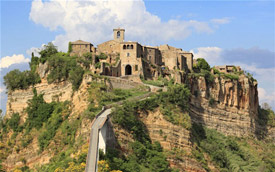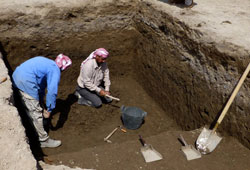redo Jump to...
print Print...
ITALY – Crumbling Italian village to charge entrance fee to pay for foundations

The residents of Civita di Bagnoregio intend to levy an entrance fee on visitors in an attempt to build up a fund to pay for engineering work and structural repairs.
ROME | One of Italy’s most picturesque and unusual medieval villages is to start charging visitors an entrance fee in a bid to raise money to shore up its crumbling foundations.
Civita di Bagnoregio perches precariously on an outcrop of friable rock surrounded by deep ravines in Lazio, the region that encompasses Rome.
Frequent rock falls have earned it the name “the dying town” and most of its inhabitants fled long ago, to be replaced by a small colony of artists, expatriates and boutique owners.
The village, 100 miles north of Rome, now intends to levy a three euro ($3.91) entrance fee on visitors in an attempt to build up a fund to pay for vital engineering work and structural repairs.
It is thought to be the first town or village in Italy to start charging an entrance fee – Venice has mulled the idea in the past as a way of controlling the crush of tourists that invade the lagoon city every day, but the idea has proved too controversial to implement.
The tourist tax will be easy to enforce in Civita di Bagnoregio – the only way to access the tiny village is via a long pedestrian bridge that spans a deep ravine.
The decision to introduce the charge was taken in the light of recent geological reports which painted an alarming picture of the precarious state of the village, which is built on crumbly tufa rock, a type of limestone.
“The money will be used for urgent structural maintenance,” said Francesco Bigiotti, the mayor of the village along with its sister settlement Bagnoregio, where many of its former residents had to move to.
Cuts to government funding, implemented by the technocrat government of Mario Monti, the prime minister, also drove the decision to start charging for entrance.
“It is clear that we must find new funds that will enable us to act quickly and independently,” the mayor told the Ansa news agency. “We need to intervene and deal with the situation resolutely.” He said new fractures had appeared in the foundations of the village which needed to be attended to “before they get any wider.”
The ticket [plan] is expected to be up and running later this month.
The village’s year-round population is about 15 but that swells to about 100 during the summer, when cafes, restaurants and boutiques open up for the tourist trade.
IRAQ – Ancient site unearthed near Ur

March 31, 2013 photo provided by Manchester University professor Stuart Campbell shows excavation in progress at Tell Khaiber, Iraq.
BAGHDAD | British archaeologists said Thursday they have unearthed a sprawling complex near the ancient city of Ur in southern Iraq, home of the biblical Abraham.
The structure, thought to be about 4,000 years old, probably served as an administrative center for Ur, around the time Abraham would have lived there before leaving for Canaan, according to the Bible.
The compound is near the site of the partially reconstructed Ziggurat, or Sumerian temple, said Stuart Campbell of Manchester University’s Archaeology Department, who led the dig.
“This is a breathtaking find,” Campbell said, because of its unusually large size – …about 260 feet on each side. The archaeologist said complexes of this size and age were rare.
“It appears that it is some sort of public building. It might be an administrative building, it might have religious connections or controlling goods to the city of Ur,” he told The Associated Press. …
Campbell said one of the artifacts they unearthed was a 3.5-inch clay plaque showing a worshipper wearing a long, fringed robe, approaching a sacred site.
Beyond artifacts, the site could reveal the environmental and economic conditions of the region through analysis of plant and animal remains, the archaeological team said in a statement. …
ISRAEL – Jewish population reaches symbolic number of 6 million
JERUSALEM | Israel’s population growth has passed a symbolically important landmark after census figures revealed the country now has six million Jews – the same number that were murdered in the Holocaust.
The new statistics mean Israel has become the world’s biggest Jewish population center, for the first time surpassing the United States, which has around 5.5 million Jews. The trend has been fed by emigration to Israel from the Jewish Diaspora. [This news coincides with Yom Hashoah; Holocaust Remembrance Day (see “Background” below for more info)]
Confirmation of the figure came as the total Israeli population passed eight million over the current Passover holiday period, which marks the exodus of the Israelites from ancient Egypt.
The non-Jewish minority consists of 1.6 Arabs, 350,000 non-Arab Christians and a third group, mostly immigrants from the former Soviet Union whose religion is not listed in the census conducted by Israel’s interior ministry.
Professor Sergio Della Pergola, a Jewish demographics specialist at Jerusalem’s Hebrew University, said the global population of Jews had reached 13.8 million – compared with 18 million before the Holocaust – but only in Israel had their numbers grown.
“Israel has indeed experienced a growth in the number of Jews last year, but world Jewry outside Israel did not fare so well,” he told Yedioth Ahronoth newspaper. “On the contrary, world Jewry has experienced negative growth.” …
(The news briefs above are from wire reports and staff reports posted at London’s Daily Telegraph and YahooNews on April 4, the Daily Telegraph on March 28th.)
Questions
1. For each of the 3 countries, give the following information:
a) capital
b) location/the countries that share its borders:
c) the religious breakdown of the population:
d) the type of government:
e) the chief of state (and head of government if different) [If monarch or dictator, since what date has he/she ruled? – include name of heir apparent for monarch]:
f) the population:
2. For ITALY:
a) list the who, what, where and when of the news item
b) What is the population of Civita di Bagnoregio?
c) Do you think it is right for the citizens of Civita di Bagnoregio to charge an admission fee? Explain your answer.
3. For IRAQ:
a) list the who, what, where and when of the news item
b) What is significant about the size of the archeological site unearthed?
CHALLENGE QUESTIONS:
- Give the biblical reference that describes when/how Abram goes out from his land (Ur of the Chaldeans) to go to the land of Canaan.
- What promises did God make to Abram at that time?
- What is Canaan called today?
4. For ISRAEL:
a) list the who, what, where and when of the news item
b) How many Jewish people are there in the world?
c) Why is the number of Jewish people in Israel significant?
d) Define diaspora; what is the (Jewish) Diaspora?
Background
ITALY
Civita di Bagnoregio was founded by the Etruscans around 2,500 years ago but the tufa plateau on which it sits has been eroding for centuries. The town went into serious decline from about the 16th century, with many houses simply sliding off the edge of the cliffs into the gorge below.
Earthquakes accelerated the damage. Italians know it as “il paese che muore” – the dying town. But the history of abandonment has preserved the village virtually as it was in the Middle Ages, making it a popular tourist attraction. (from the news brief above)
IRAQ
The complex of rooms around a large courtyard was found 12 miles from Ur, the last capital of the Sumerian royal dynasties whose civilization flourished 5,000 years ago.
The dig began last month when the six-member British team worked with four Iraqi archaeologists to dig in the Tell Khaiber in the southern province of Thi Qar, some 200 miles south of Baghdad.
Decades of war and violence have kept international archaeologists away from Iraq, where significant archaeological sites as yet unexplored are located. Still, the dig showed that such collaborative missions could be possible in parts of Iraq that are relatively stable, like its Shiite-dominated south.
Campbell’s team was the first British-led archaeological dig in southern Iraq since the 80s. It was also directed by Manchester University’s Dr. Jane Moon and independent archaeologist Robert Killick.
“This has been an opportunity to get back to an area very close to our heart for a long time,” Campbell said.
Iraq faces a broader problem of protecting its archaeological heritage. Its 12,000 registered archaeological sites are poorly guarded.
ISRAEL – YOM HASHOAH
- Yom HaShoah (Holocaust Remembrance Day) is observed as Israel’s day of commemoration for the approximately six million Jews who perished in the Holocaust as a result of the actions carried out by Nazi Germany, and for the Jewish resistance in that period.
- In Israel, it is a national memorial day.
- It is held on the 27th of Nisan (April/May), unless the 27th would be adjacent to Shabbat, in which case the date is shifted by a day.
- In other countries there are different commemorative days (Holocaust Memorial Day).
- Jews in the Diaspora may observe this day within the synagogue, as well as in the broader Jewish community.
- Commemorations range from synagogue services to communal vigils and educational programs.
- Many Yom HaShoah programs feature a talk by a Holocaust survivor or a direct descendant, recitation of appropriate psalms, songs and readings, or viewing of a Holocaust-themed film. Some communities choose to emphasize the depth of loss that Jews experienced in the Holocaust by reading the names of Holocaust victims one after another—dramatizing the unfathomable notion of six million deaths. Many Jewish schools also hold Holocaust-related educational programs on, or around, Yom HaShoah.
- Also during this day, tens of thousands of Israeli high-school students, and thousands of Jews and non-Jews from around the world, hold a memorial service in Auschwitz, in what has become known as “The March of the Living,” in defiance of the Holocaust Death Marches.
- This event is endorsed and subsidized by the Israeli Ministry of Education and the Holocaust Claims Conference, and is considered an important part of the school curriculum – a culmination of several months of studies on World War II and the Holocaust. (from wikipedia)
Daily “Answers” emails are provided for Daily News Articles, Tuesday’s World Events and Friday’s News Quiz.




